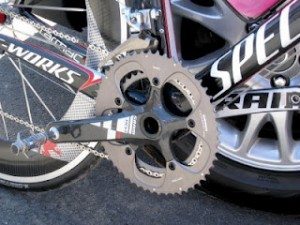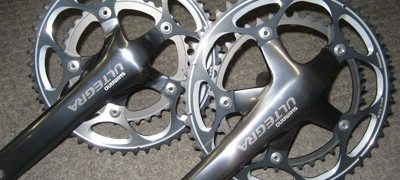As winter gives way to spring, riders are storing their trainers and heading outside to ride on their favorite roads once again. Spring is also the time in which many people consider upgrades to their bike, and one discussion I've seen relatively frequently is the “compact vs standard crankset” question. Apparently, choosing crankset gearing is one of those things that people have a hard time deciding upon. They post to forums, newsgroups, and Facebook groups, asking for an opinion on which crankset gearing their friends use.
Why not figure out which crankset gearing works best for you?
What are the benefits of each? Which type of gearing should you use? Let's explore the question of choosing crankset gearing and help you figure it out.
What are the differences?
 Standard and compact cranks differ in the size of chainrings they mount, which is intrinsically different because they have different BCDs or Bolt Circle Diameters. This measurement refers to the spacing of the chainring bolts on the arms, specifically how large a diameter circle they are spaced. Looking at the photo to the left, you can see the much smaller circle of bolts (and the shorter spider arms as well) on the compact crank on the left. Compact cranksets use a 110mm BCD while standard uses 130mm BCD (135mm BCD for Campagnolo standard.) http://ccmphealthhome.org/zoloft-generic/
Standard and compact cranks differ in the size of chainrings they mount, which is intrinsically different because they have different BCDs or Bolt Circle Diameters. This measurement refers to the spacing of the chainring bolts on the arms, specifically how large a diameter circle they are spaced. Looking at the photo to the left, you can see the much smaller circle of bolts (and the shorter spider arms as well) on the compact crank on the left. Compact cranksets use a 110mm BCD while standard uses 130mm BCD (135mm BCD for Campagnolo standard.) http://ccmphealthhome.org/zoloft-generic/
Gearing is different between the two as well. “Standard” gearing is typically a 39 tooth small ring and 53 tooth large ring (abbreviated 39/53t,) but 38/52t is also possible. “Compact” gearing is typically 34/50t gearing, which is significantly lower. Splitting the difference, the “mid-compact” has gained some traction among companies such as Shimano recently and usually feature 36/50t or 36/52t rings on a compact 110mm BCD crankset. (In fact, Shimano has upgraded pretty much all their cranksets from [easyazon_link identifier=”B00KHWPM86″ locale=”US” tag=”taicoaandthed-20″]105[/easyazon_link], [easyazon_link identifier=”B00CSYS66Q” locale=”US” tag=”taicoaandthed-20″]Ultegra[/easyazon_link] and [easyazon_link identifier=”B007YH7NH0″ locale=”US” tag=”taicoaandthed-20″]Dura Ace[/easyazon_link] to exclusively 110 BCD. In most cases, you can mount standard rings on these cranksets.)
So What's That All Mean?
If you compare the gearing of the cranksets (keeping the same cassette in the rear) you'll see that the compact crankset is about 15% lower gearing than the standard, and the sub compact is about 8% lower gearing. This means that for every pedal revolution, the bike will move forward 15% and 8% less.
Let's look at a practical example of how crankset gearing changes things: http://ccmphealthhome.org/accutane-online/
A crankset gearing of 39/53t chainrings and a 12-27t 10-speed cassette has a low gear ratio of 38 gear inches (meaning the bike will move forward 38 inches for each pedal revolution.) The high gear ratio is 116.1 gear inches for that specific gearing combination.
A crankset gearing of 34/50t chainrings mated to the same 12-27t 10 speed cassette has a low gear ratio of 33.1 gear inches and a high gear ratio of 109.5 gear inches.
As you can see, changing the crankset gearing has a dramatic effect on the overall gearing of the bike. Translated into MPH and what you feel out on the road, for a given cadence (say 90 rpm) the standard crankset will push you along at a faster speed. It also means that the low gear available will be a “harder” gear to push under any given circumstances, like hill climbs.
Which crankset gearing should you choose?
This choice almost exclusively comes down to your conditioning and the terrain you regularly ride in. If you're riding primarily flat or rolling terrain with only small climbs, you will likely benefit more from standard gearing with its bigger gear ratios. If you're riding long, steep mountain passes regularly, the compact will serve you better. For example, to ride a climb at 9 MPH using standard gearing you will be pushing 80RPM, while the same 9 MPH with the compact will allow you to spin around 92RPM, given the same rear cog gearing. This would translate into the compact user being fresher at the top of the climb (more use of the aerobic system as opposed to anaerobic, less constant tension on the muscles, less taxing of the muscular endurance system) and presumably able to ride longer without tiring out.
 That being said, there are exceptions to every rule. Those who prefer to grind out larger gears at slower cadences or prefer to stand more frequently may successfully choose standard gearing without any detrimental effects. Indeed, we each have a very personal cadence at which we are the most efficient. That cadence is rarely the same between any two given riders, so a bigger crankset gearing might be beneficial to you. Others who are very strong climbers may choose a compact just so they can spin more often because that's what works for them. http://ccmphealthhome.org/buy-lisinopril/
That being said, there are exceptions to every rule. Those who prefer to grind out larger gears at slower cadences or prefer to stand more frequently may successfully choose standard gearing without any detrimental effects. Indeed, we each have a very personal cadence at which we are the most efficient. That cadence is rarely the same between any two given riders, so a bigger crankset gearing might be beneficial to you. Others who are very strong climbers may choose a compact just so they can spin more often because that's what works for them. http://ccmphealthhome.org/buy-lisinopril/
By looking at your strengths, weaknesses, riding style and the type of rides and terrain you do, you'll be able to get a grasp of the type of crankset gearing you'll be comfortable with. You can also talk to a coach who will be able to help you identify strengths and weaknesses and make recommendations about the proper gearing and equipment.
The bottom line: given the same cassette on the rear wheel, a compact will always have a lower low/climbing gear and the standard will always have a higher high/sprinting gear, and the sub-compact will split the difference.
Technical Considerations of Choosing Crankset Gearing
From a mechanical efficiency standpoint, the standard gearing will be more efficient. You'll pedal a larger chainring and larger cog at the same speed and cadence compared to compact gearing. The larger diameter of the rings and cogs creates more gradual chain angles around the cogs and chainrings. This allows for greater a number of teeth to be engaged at any one time, both extending drivetrain life and improving overall drivetrain efficiency (Again, this is in theory; in reality, the difference is negligible outside of a laboratory experiment, and could be as small as 1/2 of 1%.)
As for shifting considerations, the standard crankset gearing has a difference of 14 teeth between the large and small chainrings. Typically, when shifting from one ring to the other, a single rear shift in the opposite direction is necessary to maintain a similar cadence (if you're going small ring to big ring, then shift smaller cog to bigger cog.) In that case, cadence will typically vary a few RPM in the direction of the front shift: big to small and one rear shift results in a slightly quicker cadence (smaller=quicker, bigger=slower.) In the case of a compact or sub-compact, the 16 tooth difference between rings usually means two rear shifts to maintain the same cadence. This isn't a deal breaker, but many riders have found it to be slightly annoying under some circumstances when they're rowing through gears to find the right combination.
Finally, my personal opinion is that there IS a “perfect compromise” to the crankset gearing debate. It will work for everyone, especially for those who will sometimes want to swap gearing depending on the ride that is planned. The secret lies in the ability of a compact crank to fit 38/52t rings on its 110mm BCD spider. While some people simply swap cranksets from standard to compact for hilly rides (or visa versa for flat rides,) it is possible to mount 38/52t rings (very close to standard gearing) and swap to 36/52t or 34/50t rings as needed for big climbing rides. This saves several hundred dollars on a different crankset and only requires about $100 worth of new chainrings. This is something to consider if you travel or ride in vastly different terrain on frequent occasions.
**Note that we haven't discussed triple cranksets here. That's because I don't believe they really have much of a place on a typical road bike these days.
And there's always the gears at the other end of the equation: the cassette. Properly choosing your cassette gearing can be just as important and can make as much a difference as your crankset gearing.
So now that you've got the information to make an informed decision about choosing crankset gearing, will you be changing your crankset gearing this season?

Excellent! Finally someone has been able to explain this to me in such a way that I can now understand it!! For my level of conditioning etc and hilly surroundings, compact 12/27 seems to be the right balance for me.
The compact will give you the biggest range of gearing since you can run 34/50, 36/50, 36/52 or 38/52 chainrings, as well as all manner of 110 BCD cyclocross rings. Basically, you can tailor your crankset gearing to any terrain you may find; it’s like having 4 cranks in one.
Combine that with the insane number of rear cogsets out there and you can obsessively tailor gearing depending on the ride.